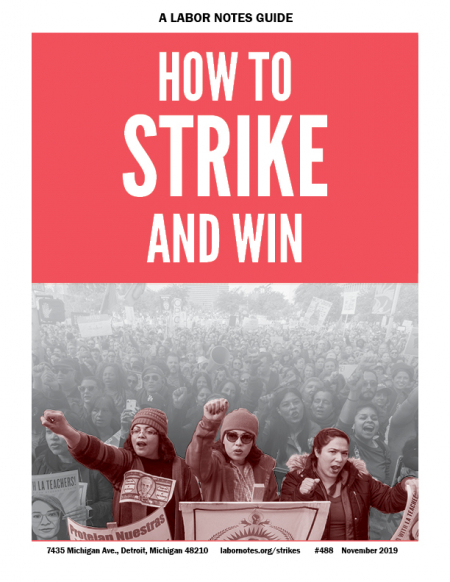How To End A Strike

A strong ending will grow out of a strong strike. Photo: UNITE HERE.
The end of a strike should be democratic, honest, and united—just like the rest of it.
How to Strike and Win
A Labor Notes Guide
labornotes.org/strikes
The Big Picture
Know Your ABC's
Building Blocks
- Turn Up the Heat
- Organize the Organized
- Democracy: Who Owns the Strike?
- Community: Who Else Owns It?
- How to End a Strike
At a Glance
Numb. Exhausted. A big sigh of relief. Frustration. These are some of the words organizers use about the end of a strike. They talk about the difference between what they wanted to get and the details of the tentative agreement, and the tensions between those who wanted to hold out longer and those anxious to get back to work.
PLAN FOR THE END AT THE START
A strong ending will grow out of a strong strike. Constant two-way communication about bargaining, daily picket line meetings, a role for everyone, a culture of defiance but of mutual care—all of these build trust and shared knowledge.
So does being clear from the get-go about the strike's goals. A vague goal ("equity for our members") ensures that members will disagree about the result: “the best we could do” vs. “it stinks.”
Gillian Russom, a board member of United Teachers Los Angeles, notes that the pressures on the bargaining team tend to make them more conservative. Spending hours across the table from management narrows their vision of what is possible. And it is exhausting.
There is little chance to experience the solidarity of the picket lines. The sense of responsibility to get people back to work grows larger each day. Bargaining starts to feel more personal than shared.
Democratic processes are vital to counter that pressure. Open bargaining (see page 22) is the strongest. That way, members know what demands are on the table and how management is responding, and everyone shares responsibility for what gets agreed to.
A little advice for bargainers: take breaks. Set limits on the length of sessions. Sleep. And be sure what happens in bargaining is communicated to members through a regular bulletin, on picket lines, at rallies, and through your Contract Action Team.
Don’t be afraid to talk to members about how you are assessing the impact of the strike, and ask how they see it. Seek out a range of perspectives. Beware of getting locked into the insider’s view. Bargainers might overestimate management’s capacity to weather the strike. Transparency and member participation are our power.
RATIFICATION: DEMOCRACY MATTERS
As the Chicago Teachers Union ended its 2012 strike, the union’s House of Delegates demanded that leaders not sell the tentative agreement to members but rather extend the strike to let them decide for themselves. (See page 11.) Officers agreed.
“I’m not going to say this is the greatest thing since sliced bread and try to sell it to them. I’m not a marketer,” said President Karen Lewis. “Our people know how to read, they know how to do math.”
This decision set a high mark for what democratic unionism looks like in a strike. Many bargaining teams are quick to declare a tentative agreement (TA) as a win and often schedule a vote after members have been sent back to work.
On the one hand, this is understandable. The team knows from inside what offers have been made, how hard management has pushed back, and the lines the union might not be able to cross. On the other hand, the very nature of insider knowledge discounts the experience of solidarity and power that workers have found on the picket line.
Russom says, “You have to have time to process the TA where questions and frustrations can come out. You have to have this plan in advance. We took a risk to go out on strike, and we get to decide when we go back.”
In the CTU strike, those discussions took place right on the picket lines. In other situations the union could rent a hall big enough to hold the membership.
As in every other aspect of the strike, “our union has always done it this way” is not a good enough reason. Should the information meeting be separate from a later ratification vote? Does breaking down into small groups make sense? Should the vote to end the strike take place with hands raised at a meeting, by secret ballot, or online?
Obviously, the entire TA, with changes indicated, should be available, as well as an honest summary.
In assessing the TA’s weak points, leaders should be clear about why they didn’t get what members wanted. Were there just too many nonunion competitors willing to take your company’s business? Was the budget shortfall just too large? Were there things the union could have done differently?
On the other hand, leaders should make clear that what members did made a difference—any gains were because of the actions and unity of members themselves.
RETURN TO WORK STRONG
Be prepared to mark the win and the solidarity that got you there. The song gets it right: solidarity is forever.

SUPPORT LABOR NOTES
BECOME A MONTHLY DONOR
Give $10 a month or more and get our "Fight the Boss, Build the Union" T-shirt.
Kristin Roberts, a CTU member, recalls that after the 2012 strike she wrote thank-you notes to each of her co-workers, and, on the first day back in, gave everyone a red carnation to wear.
After defeating every concession demanded by Verizon in 2016, victorious Communications Workers walked back in to work together wearing union shirts and chanting, “One day longer, one day stronger.”
Unions concerned about retaliation could take a leaf from fast food strikers’ book and organize a delegation of faith leaders to accompany workers back in.
Returning without a TA can occasionally be advantageous. That's what Teamsters at Golan Moving did in 2015 after a six-month strike. The labor board had found in the workers’ favor and negotiated a resolution of Golan’s unfair labor practices.
The local offered an immediate, unconditional return to work. Members were prepared to report at 6:00 the next morning. By law, Golan’s was forced to take everyone back and discharge all scabs within five days.
Managers expected strikers to return with their tails between their legs. But the union’s message was clear: workers would be ready to strike again just as soon as the busy season arrived.
Without a contract, worker leaders warned, the movers could legally strike over grievances. The company knew it was vulnerable to disruptions and other inside tactics—so it gave in and signed a contract.
REFLECT ON THE LESSONS
There will be lots of informal conversation about the experiences of the strike—lost wages, joyful moments, fears overcome, and what was won or not won. There is a lot to absorb about what worked, what didn’t work, why, and what that means for union power going forward.
Make a space for these conversations. Hold special meetings where members can reminisce, but also develop plans to defend the contract and win the next fight. Hold meetings at work, not just at the union hall, so everyone can be involved.
After the 2019 Stop & Shop strike, the Food and Commercial Workers brought strike leaders to teach a steward seminar for units that hadn’t been out.
Management, of course, will be peddling its own version of events, including its favorite, “Nobody wins a strike.”
“After every strike, or every contract, the company will spread its own version of what happened,” says retired president Jeff Crosby of IUE-CWA Local 201 at General Electric. “And it’s not just the company, but the dead weight of cynicism about everything in our society.
“People think, ‘the government sucks, the company sucks, politicians suck, the union sucks, of course we can’t get anything, because we suck.’ And there’s always, ‘They’re going to do what they want to do anyway.’”
Crosby tells of the 101-day national GE strike in 1969: “The average member will tell you we gained nothing but a nickel. But in fact we got better settlements for 30 years because of that strike—we convinced the company not to push us to a strike again.”
TRANSLATE YOUR NEW TEAMS INTO POWER AT WORK
A strike gives a real experience of power—but this doesn’t necessarily carry back to the worksite. Jeff Jones of UFCW Local 1459 said, coming off the Stop & Shop strike, “We cannot slide back into business as usual and not build on what we did.”
To prepare for the strike you built a Contract Action Team, held regular meetings, and developed a campaign of escalating actions to grow trust and courage. Don’t let these disappear. The structures that gave you a win are needed every day.
Use your structures first to reflect and celebrate, and next to bring collective power onto the shop floor. Convert your CAT into a permanent Member Action Team. There’s a contract to defend. There may be battles against retaliation to take up.
BUILD UP NEW LEADERS
Throughout the strike, pay attention to who is stepping up, who are the people others listen to, who is emerging as a leader. Then follow up.
“The real success is when the natural leadership in the strike gets invited to continue,” says Richard de Vries, a longtime business agent for Teamsters Local 705. “They change their relationship with the union, or get involved in a caucus that goes after the incumbents that failed to incorporate them.”
Russom agrees: “Make a plan to thank the specific individuals who stepped up, and make a plan to talk to them about what they think it means to be involved in the union. Do a new round of one-to-ones.”
PREPARE FOR NEXT TIME
“You are now at a different level and you can never go back,” says Jones. “It is a different ball game. The company will come at it in a different way—and we need to be prepared too.”
Reflecting on lessons learned, identifying and developing new leaders: the cycle of organizing continues.





